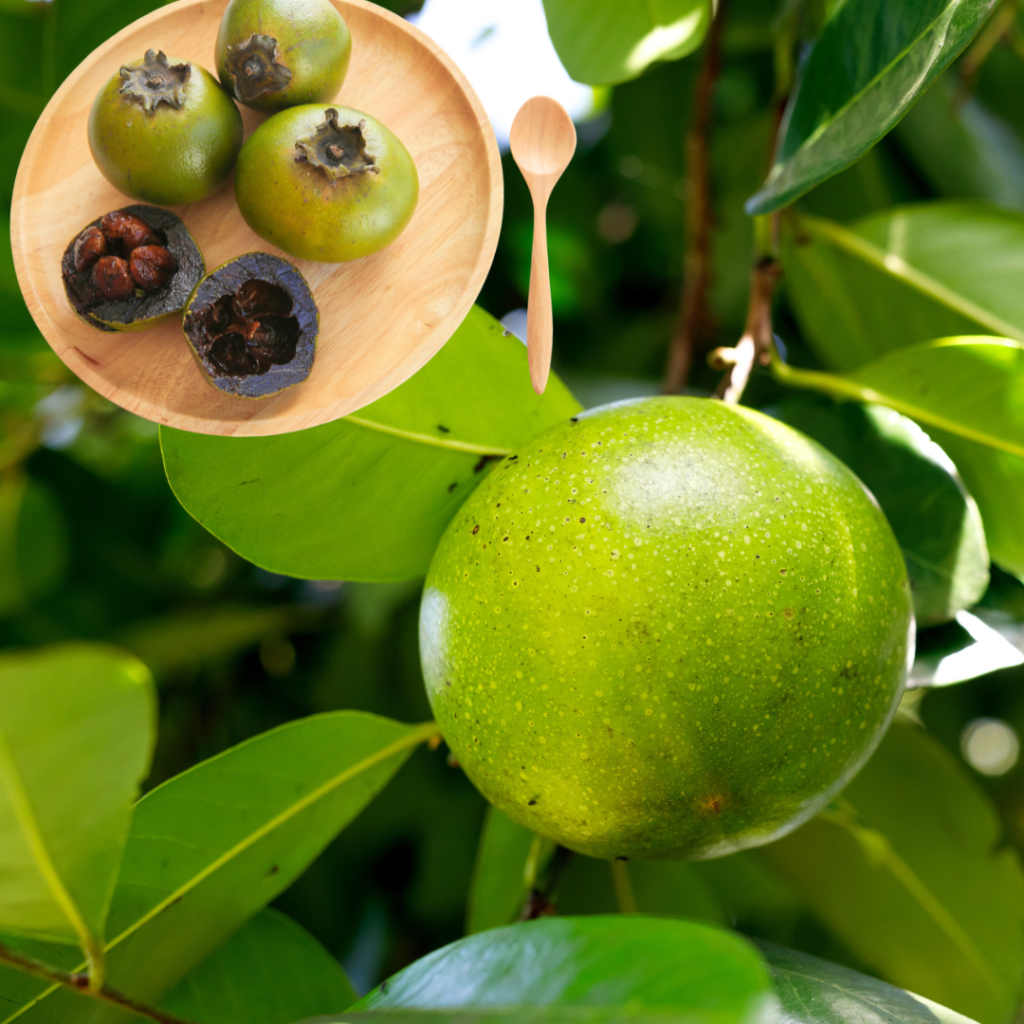At the Sarasota County UF/IFAS Extension Office, we’ve been cultivating a Food Forest to showcase the most productive, unique, and often underutilized fruits suited to our distinctive southwest Florida climate. Through this project, we aim to inspire and educate our community by offering a firsthand look at these remarkable trees and shrubs, allowing visitors to sample flavors before purchasing, and providing opportunities to gather seeds and cuttings.

If you’ve ever wished for a lush tropical tree that produces numerous hefty fruit while enhancing the beauty of your landscape, one option is the Pudding Sapote (Diospyros digyna). Commonly known as the Black Sapote or Chocolate Pudding Fruit, this underutilized, super productive tree is native to Central America but thrives in Florida’s USDA hardiness zones 10 to 12. While I agree it has a pudding like consistency, the chocolate is more a reference to color than taste. Its adaptability, lush foliage, and bountiful harvest make it a perfect choice for gardeners and landscapers looking to add foodscaping functionality to their yard.
Why Choose Black Sapote for Your Landscape?
Aesthetic Appeal
The Black Sapote grows into a medium to large tree, reaching heights of 25-80 feet with a round, dense crown. Its large, shiny, dark green tropical leaves provide year-round beauty and a striking spring flush of new growth and flowers. Properly located and cared for, it can serve as a majestic centerpiece in any landscape.
High-Yielding Fruit Tree
One of the most prolific fruit producers, the Black Sapote delivers an abundance of green fruit that transforms into a soft, dark, pudding-like texture delight when fully ripe. January is one of the months they are producing the ripest fruit. Its texture, flavor, and versatility make it a favorite among those in the know. From pies to smoothies, it’s an underutilized culinary treasure waiting to be explored. Its flavor is unique and tends to be polarizing—people either enjoy it or find it unappealing. Definitely one to taste before you plant. A black sapote has a smooth, custard-like texture and a mild chocolatey flavor, often likened to chocolate pudding. Its sweetness carries hints of caramel and honey, with a subtle squash-like undertone. To enjoy it at its best, wait until it’s fully ripe and soft, as unripe black sapote can be astringent.
Caring for Your Black Sapote
Location and Planting

Choose a sunny location with plenty of space for this tree to reach its full potential. Clear turfgrass from beneath its canopy to minimize competition for nutrients and water. Consider its ultimate size to ensure it has enough room to grow without frequent pruning, which can detract from its natural beauty and yields.
Culinary Uses: A Versatile Treat
When fully ripe, Black Sapote assumes a flavor, texture, and color often likened to chocolate pudding. Its sweet, subtle taste pairs wonderfully with honey, vanilla, cream, or orange juice. Here are just a few ways to enjoy this delectable fruit:
- Desserts: Black Sapote mousse, cheesecakes, custards, tortes, and pies.
- Toppings: Mix the pulp with icing sugar, rum, or brandy for a unique dessert topping.
- Baking: Use the pulp in breads or cakes.
- Frozen Treats: Add it to ice cream or use it as a flavoring.
- Pairings: Serve as a sauce with papaya and other tropical fruits.
Ecological and Functional Benefits
Beyond its culinary and aesthetic appeal, Black Sapote offers shade and serves as an ornamental tree, contributing to a comfortable and inviting outdoor space. Its dense canopy can provide deep shade in our summer months and excess fruit can feed birds, fruit-eating butterflies like the beautiful malachite, and more! While it’s excess fruit could attract rodents, putting in a barn owl box nearby can be a great control to keep them from becoming a pest.
An Underrated Treasure
Despite its many advantages, the Black Sapote remains underutilized in Florida landscapes. Its adaptability to the state’s climate, coupled with its beauty and fruit production, make it an excellent addition to gardens, parks, and residential yards.
Whether you’re a seasoned gardener or a novice looking to try something new, the Chocolate Pudding Fruit is sure to impress. Plant one today and enjoy the many benefits this extraordinary tree has to offer!
Resources
- UF/IFAS on Black Sapote in Florida: https://edis.ifas.ufl.edu/publication/HS305
- UF/IFAS Landscape Plants on Black Sapote: https://hort.ifas.ufl.edu/woody/Pages/diodig/diodig.shtml
- Growables on Black Sapote: https://www.growables.org/information/TropicalFruit/BlackSapote.htm
- Florida Department of Agriculture and Consumer Services on Black Sapote fruit: https://www.fdacs.gov/Consumer-Resources/Buy-Fresh-From-Florida/Tropical-Fruit/Black-Sapote
During the preparation of this work, the author used ChatGPT to help build the blog post. After using this tool/service, the author reviewed and edited the content, and takes full responsibility for the content of the public
 7
7
